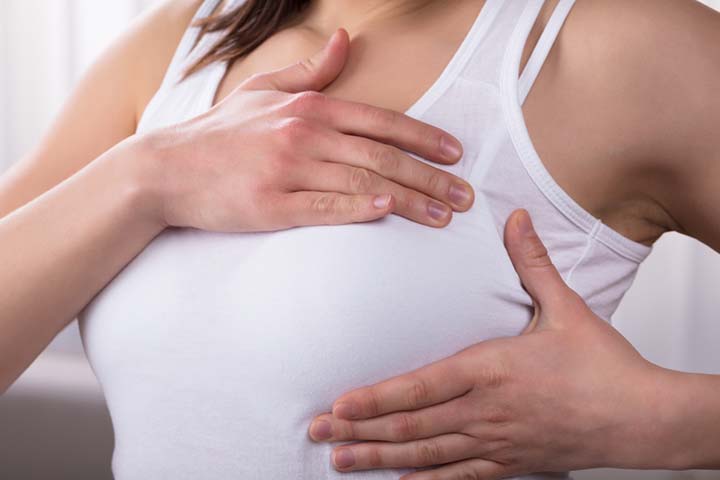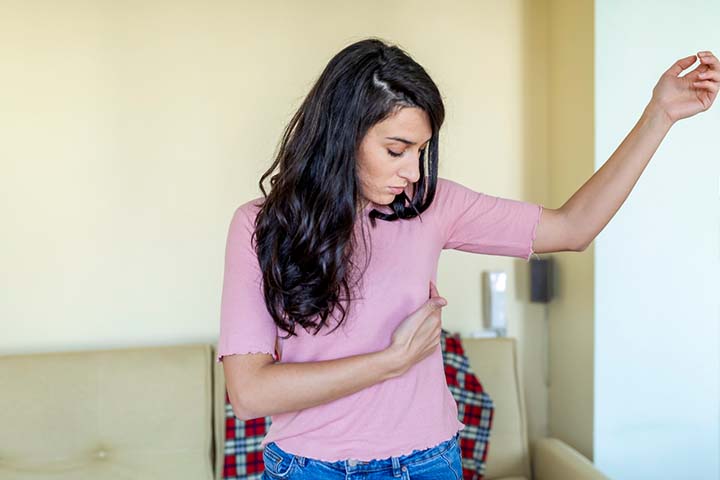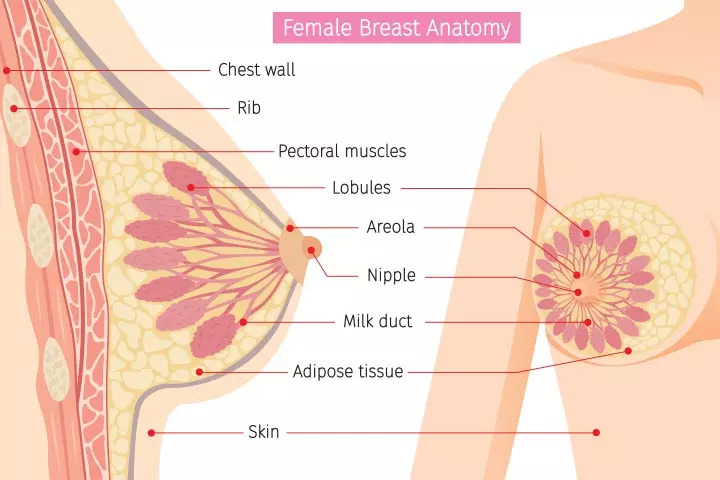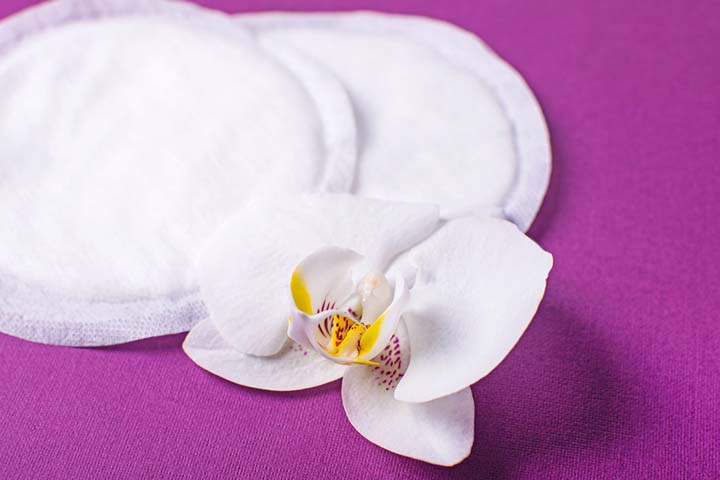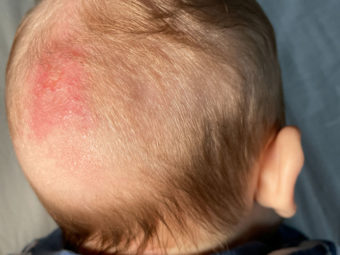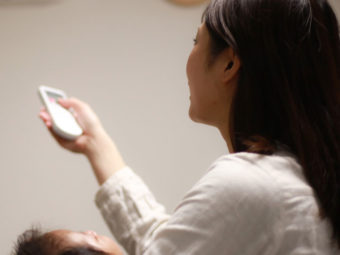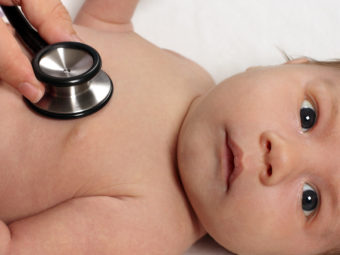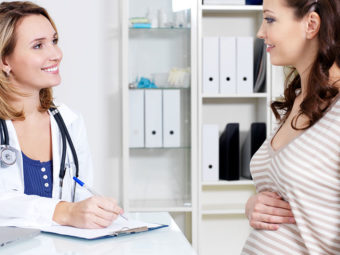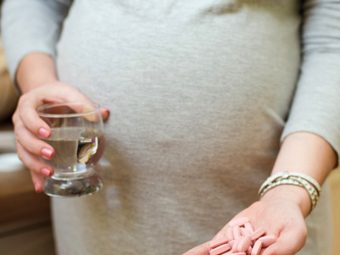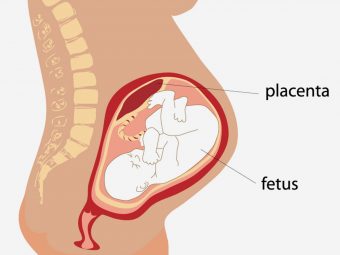
Image: Shutterstock
Breast pain during pregnancy is a common occurrence as the breasts undergo many changes during this period. Although the causes of breast pain during this period may not be due to an underlying disease or cancer, it is advised to consult with your doctor.
Read on to know more about the symptoms and causes of breast pain during pregnancy, the concerning symptoms you should watch out for, and ways to manage the pain.
Is Breast Pain Normal During Pregnancy?
Image: Shutterstock
Breast pain, also called mastalgia, could occur as early as one to two weeks after conception. According to a survey conducted by the American Pregnancy Association (APA), 17% of women reported changes in the breast as an early symptom of pregnancy (1).
Pregnancy symptoms vary, and not all women may have breast pain. Sometimes, breast tenderness may also be a sign of the beginning of a menstrual cycle. Therefore, perform a home pregnancy test or see a doctor to confirm pregnancy.
 Did you know?
Did you know?Which Parts Of The Breast Hurt In Early Pregnancy?
During early pregnancy, women may experience pain at one specific point or across one or both breasts. In some cases, women may also experience a dull ache or pain that moves outwards into the armpits.
Symptoms Of Breast Pain During Pregnancy
Image: IStock
Breast pain during pregnancy can present itself with the following symptoms (2) (3).
- Tingling sensation in the breasts
- Soreness in one or more breasts
- Tenderness in one or more breasts
- Increased breast sensitivity, especially during late pregnancy
Breast pain during pregnancy is usually dull, and stabbing or sharp pain may not be common. If your breast pain is causing too much discomfort and affecting your day-to-day activities, then it is good to seek medical advice.
What Causes Breast Pain During Pregnancy?
The secretion of several hormones during pregnancy causes mammary gland tenderness and pain in the breasts. The following are a few reasons why breasts become painful during pregnancy (2) (4).
- First trimester: The breasts undergo changes due to the release of estrogeniXA hormone produced by the body that aids in the formation of long bones and the development of female sex traits , progesteroneiXA sex hormone vital for female reproduction , and prolactiniXA hormone that the anterior pituitary gland releases to promote milk production upon delivery hormones. These hormones cause a growth in the blood vessels and proliferationiXQuick reproduction of cells, components, or organisms of the milk lobulesiXA gland that produces milk . These changes may increase the sensitivity and tenderness of the breast.
- Second and third trimesters: Due to the increased progesterone levels, the proliferation of milk lobules becomes more prominent.
The hormones prepare your breasts for milk production. Therefore, milk lobules and milk ducts within your breast constantly stretch during pregnancy, thus causing discomfort.
 Point to consider
Point to considerImage: Shutterstock
When Should You Be Concerned?
If the following symptoms accompany breast pain during pregnancy, then see a doctor (4) (5).
- Presence of new lumps: Milk ducts within breast often clog to present as tender lumps on the outside. These lumps usually go away with warm compresses and massage. However, if the lumps persist and new lumps develop, then see a doctor.
- Lump in the armpit: Sometimes, accessory breast tissue may emerge in the armpit region. It is good to get the lump inspected by a doctor.
Image: Shutterstock
- Painful lumps: If lumps on your breast are red, painful, and hard to touch, then see a doctor.
- Chronic discharge from nipple: Colostrum, the baby’s first milk, may leak from the nipple as a yellow and thick liquid. The discharge usually happens when the breasts are massaged or stimulated, and it is normal. But if the discharge is chronic, smells foul, and is accompanied by blood, then see a doctor.
- Change in breast or nipple color or structure: Changes in the skin of the breast can be alarming, particularly if they are new, persistent, or show signs of getting worse. While many skin changes during pregnancy are harmless, it’s essential to pay attention to alterations like skin puckering or dimpling, changes in texture, thickened skin with larger pores, warmth, pain, irritation, or redness. Additionally, scaling, thickening, or flaking of the nipple or areola should be taken seriously (6). See a doctor if you see a dimpling of the nipple or a part of the breasts. If you suspect an abnormal change in the shape of the breasts or a change in the color of the breast tissue, then get it checked by a healthcare provider.
- Palpable lymph nodes: Palpable lymph nodes in the breast and underarm area aren’t uncommon. Changes in the breast tissue and increased blood flow may make them more noticeable during lactation. However, enlarged or persistent lymph nodes, especially in the axillary region (armpit), must be evaluated by a doctor. These lumps may be a sign of an underlying issue, like infections or breast-related concerns.
 Expert says
Expert saysHow To Reduce Breast Pain During Pregnancy?
These tips may help you manage breast pain or sore breasts, and brace yourself for the expected changes (3)(5).
- Buy a good supportive bra: As your breasts grow during pregnancy, you may want to buy a good supportive bra. According to the NHS UK and American Pregnancy Association, a good bra should check the following boxes.
- The cup covers the entire breasts with no loose tissue bulging outwards
- The bra has a deep band under or beneath the cups
- Shoulder straps stay in place when you lift arms up
- Adjustable closure (it has been observed that back-fastening bras offer more comfort and flexibility than front-fastening bras)
- Straps remain close to the body but without digging into the skin
YouTuber and mother of three Natalie Bennett had sore breasts during pregnancy, due to which she was unable to wear regular bras. Recalling her experience, she says, “I couldn’t wear bras with underwire or anything too tight and supportive. So, I opted for a soft bra without an underwire but with a nice, supportive band underneath. It made me much more comfortable, providing room for my changing body (i).”
- Try a cotton sports bra: If your breast size has increased significantly, causing discomfort during sleep or daily activities, you may consider using a cotton sports bra.
- Use a disposable or washable fabric pad: If you are experiencing any leakage (colostrum) from your nipple that is noticeable on your clothes, you may use a disposable or washable fabric pad inside your bra.
Image: IStock
- Use warm compresses or ice packs: Soak a cloth in warm water and place it over the breasts to help ease the soreness. You can also place an ice pack to ease mammary gland pain.
- Avoid direct physical contact: Often direct physical contact with clothes, seatbelt, purse strings, or even spray from your showerhead can increase discomfort and pain. Use caution and adjust the use of such items for your comfort.
 Quick tip
Quick tipHow Long Do You Have Sore Breasts During Pregnancy?
Breast soreness during pregnancy may be intermittent or through the pregnancy. The discomfort may peak during the later stages. However, the soreness may become more manageable and tolerable as you approach the last trimester.
Other Changes In Breasts During Pregnancy
According to obstetrician and gynecologist Dr. Nandita Palshetkar, “Aside from breast pain, there are other breast changes women may experience during pregnancy. These include darkening of the nipples and areola, enlargement of the breasts, and visible veins on the breast skin. These changes are all normal and can be attributed to hormonal fluctuations.”
It is good to know the changes that could happen to your breasts during pregnancy (7).
- Darkening of nipples and areolas: You may notice the darkening of nipples and areolas as the pregnancy progresses. This happens due to the presence of hormones that alters skin pigmentation.
- Darkening of veins: The veins may become more prominent on the breasts due to increased blood supply. This happens due to the proliferation of blood vessels.
- Stretch marks: The increase in breast tissue may result in stretch marks on the breasts.
- Prominent Montgomery’s tubercles: The areola contains small bumps called Montgomery’s tubercles that surround the nipple. These bumps are part of areolar glands that produce secretions to keep the nipple lubricated. Pregnancy can cause Montgomery’s tubercles to increase in size and become noticeable as raised bumps around the nipple.
- Increase in the areola and sticking out of nipples: The size of the areola may increase, and the nipples may stick out more than usual.
Frequently Asked Questions
1. Can only one breast hurt during pregnancy?
Yes, the symptoms of breast pain vary from one to another. Some may experience pain or discomfort in one breast. However, if you have noticed any sharp or stabbing pain, a new lump, or discoloration of skin or nipple, visit your healthcare provider.
2. How long after giving birth will breast pain last?
You may experience breast pain after childbirth and during lactation due to engorgement (breasts overfilled with milk), blocked milk ducts, or mastitisiXInflammation of the mammary gland caused by bacterial infection (3). Some women may also experience nipple sensitivity, discomfort, and pain in the nipple area due to sore or cracked nipples. See a doctor if these problems cause severe discomfort or breastfeeding pain.
3. What part of the breast hurts in early pregnancy vs. period?
In the early months of pregnancy, you may feel soreness down the sides of your breasts and tingling and soreness in your nipples because the milk duct system in your breasts is growing. During periods, on the other hand, one or both breasts may hurt, and you could also feel a radiating feeling in the underarm area. The pain can be barely noticeable for some, while it could be relatively severe for others (8) (9).
Symptoms such as breast pain may often remain unchecked during pregnancy since it is a common and early sign of pregnancy. You may experience breast pain, sensitivity, or soreness in intervals or consistently throughout the pregnancy. However, do not be alarmed if your other pregnant friends or relatives do not experience similar symptoms since every pregnancy is different. You may effectively manage the pain with some helpful home remedies. However, if the breast pain persists with other concerning symptoms such as a lump and fluid discharge, consult your doctor to seek timely treatment in case of an underlying issue.
Infographic: How To Relieve Breast Pain During Pregnancy Naturally?
Breast pain during pregnancy is common. Along with cause-dependant treatment, trying some natural remedies can help alleviate pain and discomfort. Our infographic lists simple natural remedies expecting moms can try after consulting their healthcare provider. Go through these remedies and share them with fellow expectant moms who might also have similar issues. Illustration: Momjunction Design Team
Key Pointers
- Breast pain is a common symptom during pregnancy due to hormonal changes and breast tissue growth.
- Wearing a supportive and well-fitting bra can help relieve breast pain.
- Warm compresses and massages can provide relief from breast pain.
- Darkening of the areola around the nipples is also a common observation during pregnancy.
- If you feel lumps in the armpit or experience chronic nipple discharge, consult with a doctor immediately.
Personal Experience: Source
MomJunction articles include first-hand experiences to provide you with better insights through real-life narratives. Here are the sources of personal accounts referenced in this article.
i. FIRST TRIMESTER MUST-HAVES + ESSENTIALS | Pregnancy Favorites Series | Natalie Bennett;https://youtu.be/vE6_NFRq6UE
References
- Pregnancy symptoms-Early signs of pregnancy: American Pregnancy Association. (n.d.)
- Breast changes during pregnancy: Ireland’s Health Services. (2018)
- Possible breast changes during and after pregnancy: National Health Service (NHS) Trust. (n.d.)
- Yu, J. H., Kim, M. J., Cho, H., Liu, H. J., Han, S. J., & Ahn, T. G. (2013). Breast diseases during pregnancy and lactation: Obstetrics & gynecology science, 56(3), 143–159
- Breast changes during pregnancy: American Pregnancy Association. (n.d.)
- Breast health diagnosis & treatment: Virginia Mason Franciscan Health
- Breast changes during pregnancy: Family Health Service, Dept. of Health, The Government of Hong Kong Special Administrative Region of the Republic of China. (n.d.)
- Normal Breast Development and Changes; John Hopkins Medicine
- Breast Pain (Mastalgia); John Hopkins Medicine
- 8 third trimester pains and how to deal with them: UT Southwestern Medical Center





